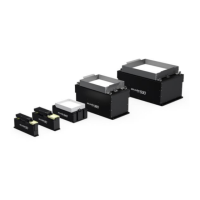There are different ways to start adjusting the parameters:
• Import an already configured vibration set (strongly encouraged)
Export a vibration set (for example vibration set 26) as an .Fconf file then import it
in the vibration set you assigned to your part type.
• Copy/paste a platform vibration
Method mainly used during the fine-tuning of the parameters of a vibration set.
Copy/paste option for one vibration at a time.
• Start tuning from zero (not recommended)
Some indications are given for the frequency range (references below).
Adjust the parameters in order to obtain rapid and smooth part movement on the platform
and parts that jump only during the ‘Flip’ vibration. For coarse-tuning, you may take
advantage of continuous mode, which enables you to change parameters such as
frequency, amplitude etc. while the platform vibrates continuously. For fine-tuning, better
results are obtained when the vibration duration corresponds approximately to the real
situation.
• Part displacement vibrations (A – H):
Use the sinus signal.
1. Find an adequate frequency. Once the optimal frequency is found, you
may reuse the same frequency for adjusting the other platform vibrations.
2. Adjust the amplitude of the different actuators.
3. Adjust the vibration duration so that the parts completely cross the
platform in a given direction.
• ‘Flip’ vibration (I):
Use the sinus signal.
1. Find an adequate frequency.
(Asycube 50 & 80: See Table 5-2, Asycube 240, 380 and 530: See Table
5-3)
2. Adjust the amplitude.
3. Adjust the vibration duration; short, but enough time in order for the parts
to flip.
• Asycube 240, 380 and 530: ‘Long’- and ‘Short axis centring (J and K):
Use the sinus signal.
1. Find an adequate frequency.
(Asycube 240, 380 and 530: see Table 5-3)
2. Adjust the amplitude.
3. Adjust the duration.
Note that the procedure is identical when using the Easy-Tuning method, the adjusting

